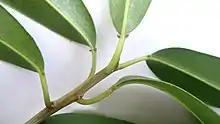| Sapium glandulosum | |
|---|---|
 | |
| Scientific classification | |
| Kingdom: | Plantae |
| Clade: | Tracheophytes |
| Clade: | Angiosperms |
| Clade: | Eudicots |
| Clade: | Rosids |
| Order: | Malpighiales |
| Family: | Euphorbiaceae |
| Genus: | Sapium |
| Species: | S. glandulosum |
| Binomial name | |
| Sapium glandulosum (L.) Morong | |
| Synonyms | |
|
many[2] | |
Sapium glandulosum is a species of tree in the family Euphorbiaceae. It is native to the Neotropics from Mexico and the Caribbean south to Argentina, and it has been cultivated elsewhere.[3][4] It is the most common Sapium species.[4] Its common names include gumtree,[5] milktree,[6] leche de olivo, and olivo macho.[7]
This is a species of tree up to 30 meters tall, usually with some buttress roots and multiple trunks. Smaller woody parts can have short, thick spines. It has a thin, patchy, peeling, scarred outer bark and a granular inner bark. It produces large amounts of milky latex. The alternately arranged leaves have toothed oblong or oval leaves up to 27 centimeters long by 8 wide. New leaves have gland-tipped teeth. The species is monoecious. The inflorescence is a spikelike arrangement of clusters of male flowers with a few female flowers at the base. The tiny rounded purple male flower is barely over a millimeter long. The female flower has 3 styles about 2 millimeters long. The fruit is a greenish-brown, rounded capsule up to a centimeter long which splits into 3 segments, each holding a seed. The seed is covered in a thin layer of red pulp.[4][7]
This tree grows in tropical moist and wet forests.[7]
The copious latex is of high quality and can be used to make rubber. It is difficult to harvest, so it is not commercially useful.[4]
References
- ↑ Botanic Gardens Conservation International (BGCI).; IUCN SSC Global Tree Specialist Group (2018). "Sapium glandulosum". IUCN Red List of Threatened Species. 2018: e.T37003A135834090. doi:10.2305/IUCN.UK.2018-2.RLTS.T37003A135834090.en. Retrieved 17 November 2021.
- ↑ Synonyms: Sapium glandulosum. The Plant List.
- ↑ Kew World Checklist of Selected Plant Families
- 1 2 3 4 Sapium. Malesian Euphorbiaceae Descriptions. National Herbarium Nederland.
- ↑ Sapium glandulosum. USDA PLANTS.
- ↑ "Sapium glandulosum". Germplasm Resources Information Network. Agricultural Research Service, United States Department of Agriculture. Retrieved 19 January 2018.
- 1 2 3 Sapium glandulosum. Smithsonian Tropical Research Institute.
